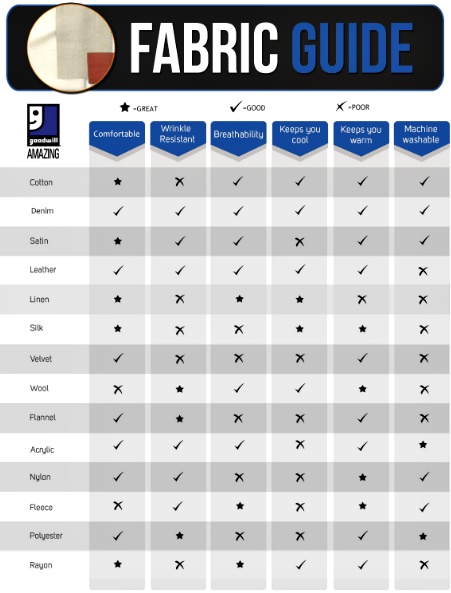 Choosing the right material to wear can be tricky. It’s great to have an outfit that looks good on you, but you also want to think about comfort, durability, and ease of maintenance. Like many other shoppers, I used to pay attention to brand, color and style, but never worried about the material. I never understood the importance of choosing the right type of fabric until I saw items in my closet starting to fade or shrink over time.
Choosing the right material to wear can be tricky. It’s great to have an outfit that looks good on you, but you also want to think about comfort, durability, and ease of maintenance. Like many other shoppers, I used to pay attention to brand, color and style, but never worried about the material. I never understood the importance of choosing the right type of fabric until I saw items in my closet starting to fade or shrink over time.
Aesthetics, durability and comfort are the most important factors when choosing material. Some fabrics complement shape, some are better for working out, and certain types of fabrics simply should not be worn during certain seasons.
Here is a list of popular fabrics from which most clothing is made:
Acrylic—Acrylic is lightweight, soft, and warm. It absorbs and releases moisture very quickly. This material does not shrink very easily but can attract static. It can be machine-washed and ironed at low temperatures.
Cotton—Cotton is popular in warm climates because it is soft, lightweight, and can absorb sweat very easily. Cotton is very comfortable as well as durable. It is machine washable and can be ironed at very high temperatures.
Denim—Denim is wrinkle resistant and absorbs moisture easily. Denim is easy to maintain because it does not need to be washed frequently. It is machine washable and can be ironed at high temperatures. When cleaning denim, turn the item inside out before washing to preserve color.
Fleece—Fleece is warm and soft. It is lightweight, making it easy for air to flow through the material. It can be machine-washed and ironed at low temperatures.
Leather—Leather is warm and will mold to fit your shape. Leather is one of the most durable fabrics. It repels liquids, resists staining, is fire resistant, and it is very difficult to tear. Leather should not be ironed directly and must be dry-cleaned.
Linen—Linen absorbs sweat and dries quickly, making it popular for the summer months. As a lightweight material, it wrinkles easily. Linen has twice the strength of cotton and absorbs and handles perspiration easily. Although you can iron linen, you should wash it by hand or have it dry-cleaned.
Nylon—Nylon is perfect for traveling. It dries quickly and repels dirt. Although nylon is strong, it weighs less than any other commonly used fiber. Nylon does not absorb moisture well and can make you feel hot and clammy in warmer weather. It can be machine-washed in warm water and ironed at low temperatures.
Polyester—Polyester does not wrinkle. It is strong and durable and dries quickly. Polyester does not absorb moisture well, which makes it a poor choice for wearing in warm temperatures. Polyester can be machine-washed in warm temperatures but must be dried and ironed at low temperatures to prevent melting.
Rayon—Rayon is strong and extremely absorbent. It is soft and comfortable but can wrinkle easily. Rayon must be washed by hand or dry cleaned because it can burn at high temperatures. Rayon can be ironed at low temperatures.
Silk—Silk is a luxurious, lightweight, durable and soft fabric. It adapts well to temperatures by keeping your body temperature cool in the summer and warm in the winter. Although silk is one of the strongest natural fibers, sunlight and sweat will cause it to weaken. Silk can be machine-washed in cold water and washes well without losing its color, shape, size or strength.
Spandex—Spandex is a popular material because it can be stretched many times its size without losing the ability to go back to its original shape. It is lightweight, strong, and allows freedom of movement. Spandex is perfect for working out because of its resistance to abrasion, perspiration, and detergents. It can be machine-washed in cold water but should not be dried.
Wool—Wool has the ability to keep you warm in the winter and cool in the summer. It retains warm air and keeps out moisture. A disadvantage is that wool becomes heavy when wet and takes longer to dry. Wool is strong, making it dirt and flame resistant. A benefit of wool is that it does not need to be cleaned after every use. It can be both machine-washed and dry-cleaned.
Fabric selection is often overlooked but is extremely important when you consider the time it takes to care for your clothes. Some items can be machine-washed, some require dry-cleaning, and some require air-drying. Each item you buy will have instructions—usually on the tag—to ensure the proper care. When shopping, look for items that are easy to care for. This will prevent expensive trips to the dry cleaners but still ensure longevity in your items.









